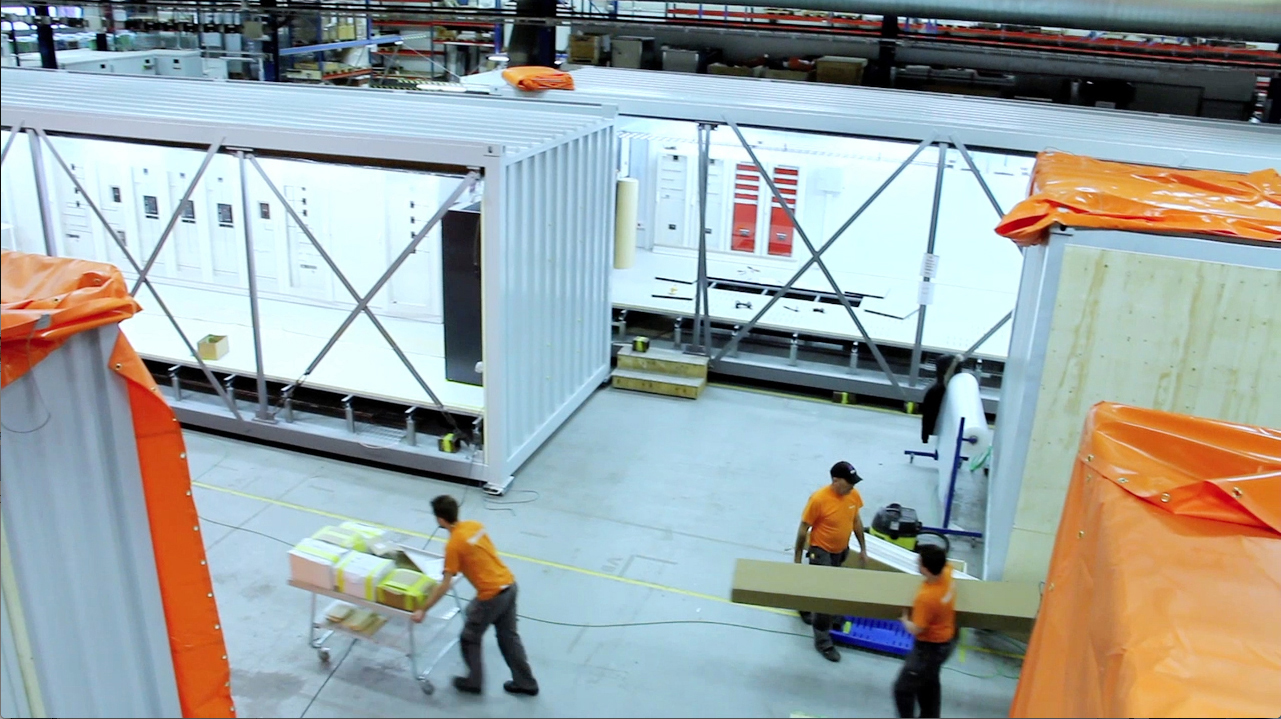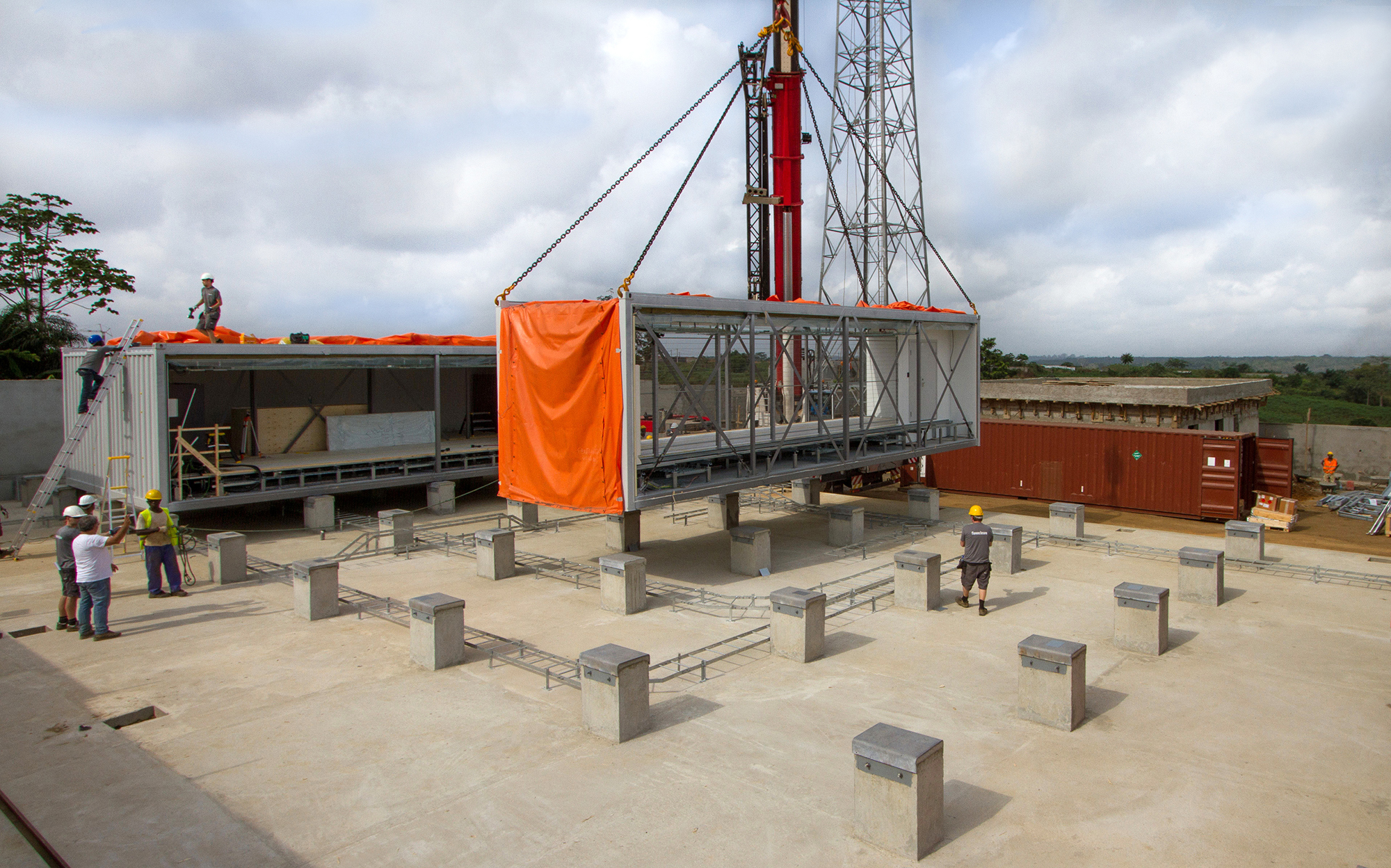Prefabricated or ISO container - which way for ultimate data centre flexibility?
It is clear that traditionally built brick and mortar ultra-high performance data centres are increasingly a thing of the past. Prefabricated facilities represent the future of data centre design worldwide. That said, what exactly is a prefabricated data centre?
By Jos Baart, Vice President Sales & Marketing, Flexenclosure.
A prefabricated data centre is one that is more or less fully constructed with all component systems in a clean factory environment and pre-tested before being shipped to the side for final assembly. For many, the word 'prefabricated' will instantly conjure up an image of a standard ISO shipping container. In fact, prefabricated data centres and ISO containerised data centres are two very different things, and which of the two you choose will depend entirely on the use it is to be put to.

Installing and testing systems for a prefabricated eCentre data centre in Flexenclosure’s factory in Sweden
Increasing demands on modern data centres
The demands operators are placing on their facilities (driven by the expectations of their customers) have become significantly more onerous over the past few years. This has resulted in the evolution of the modern data centre into a fully integrated machine, in which the systems for power, cooling, security and safety are expected to work seamlessly together. Further, the integration of these systems is constantly being fine-tuned to secure lowest possible energy consumption, highest possible site integrity and the most efficient use of resources. And in the case of colocation services, this level of performance is now seen as table stakes for any hosting provider to be able to attract and retain corporate customers.
If this description resonates with your expectations of a data centre, then building it with a set of containerised ISO modules simply won’t work.
Combining system standardisation with facility flexibility
The data centre industry has seen a great deal of effort put in to the standardisation of systems and processes. That said, the one element that will almost always need to be a bespoke solution is the building itself. And while significant progress has been made in standardising modular sub-systems, the building will need to be adaptable to the customer’s specific requirements; physical site conditions; local environmental conditions; the type of business it supports; internal configuration required and it will also need to seamlessly integrate with pre-existing facilities.
This is not to say that the building itself can’t be modular too. On the contrary, a prefabricated modular approach to data centre construction will provide the level of flexibility required to meet the requirements I mentioned a moment ago. But not any modular system will do, and this is where the ISO containerised pitch falls apart.
Containerised limitations
Containerised solutions are, broadly speaking, self-contained mini data centres, typically housed in a 20 or 40ft ISO container. In scenarios where a single unit of no more than nine racks (or so) is required, there is no denying that they are a compelling proposition. But for a medium-sized or larger facility, containerised solutions are severely limited in terms of their flexibility. Of course multiple units can be laid out in rows or stacked on top of each other, but the end result is simply a collection of mini data centres - each rigidly limited in terms of its initial configuration flexibility or adaptability to the operator’s potential future needs.
Multiple small spaces of fixed dimensions are clearly not optimal for maximising the efficiency of the overall floor area, as immovable internal walls result in a lot of dead unusable space. With standardised containerised solutions, you also can’t reap the operational and financial benefits of scaling certain systems for the entire site - having, for example, a single larger UPS for the overall facility rather than a multitude of small UPS systems, one per container. And with a standard container height of 2.9m, there is no flexibility in rack height and no possibility for a raised floor or suspended ceiling.

Lifting prefabricated eCentre data centre modules into place for MTN in Cote d’Ivoire
The prefabricated answer
A prefabricated data centre (e.g. Flexenclosure’s eCentre) won’t suffer from any of these containerised limitations. Given that they are constructed from purpose-designed, much larger and more versatile modules than ISO containers, they typically provide the flexibility of any architect-designed building structure but without the complexity of an on-site project. They can be created with repeatable designs (if required), but are always fully adaptable to the customer’s specific needs.
Do you need an infinitely configurable open white space for 50, 100, 500 or any specific number of racks, providing you the freedom to decide how to best place the racks in the available space? You can have it. Do you need multiple technical spaces and rooms to conform to Uptime Tier certification, local regulations, your own corporate standards, or to provide configurable secure caged areas for your customers? You can have that too. Will your data centre be built at a location that requires additional construction features to withstand seismic shock, exposure to salt, or extreme weather conditions? No problem. Is your site footprint smaller than you’d like it to be? That’s ok, just build prefabricated on multiple floors.
And these are only a handful of many examples where containerised solutions have inherent limitations whereas prefabricated solutions don’t. Additional benefits of prefabricated facilities are high ceilings to accommodate higher raised floors, taller racks, higher power density, false ceilings for hot air containment, multiple cable layers, a wider variety of cooling systems, the list goes on…

Completed prefabricated eCentre data centre built for ACS in Luanda, Angola
Are prefabricated data centres always the preferred answer?
There are definitely scenarios where a containerised data centre makes sense. In the case of functional units, like a power module, ISO containers come in to their own. And depending on your business plans, ISO modules can be useful for temporary scaling purposes or for immediate recovery in the event of a mission-critical disaster.
But if you want a data centre that allows for flexibility, scalability, short and controlled delivery time, a high quality end result and without the risk of tricky surprises and delays the likes of which are often thrown up in an on-site construction project, the prefabricated approach is definitely the way to go.
Of course you should look for a supplier that not only has the technical ability to build the right product in its factory, but also one that has the operational experience to deliver, install and commission it on site. That will give you peace of mind.
 Author Bio: Jos Baart is a highly skilled sales leader with over 20 years experience in the global ICT industry. His previous roles include senior strategic business development, product marketing, sales and sales support positions at Ericsson (both country and group level) and at Lavastorm Analytics where he led the EMEA Sales function. Jos studied Electronics and Marketing Management in Eindhoven and Utrecht, The Netherlands.
Author Bio: Jos Baart is a highly skilled sales leader with over 20 years experience in the global ICT industry. His previous roles include senior strategic business development, product marketing, sales and sales support positions at Ericsson (both country and group level) and at Lavastorm Analytics where he led the EMEA Sales function. Jos studied Electronics and Marketing Management in Eindhoven and Utrecht, The Netherlands.







